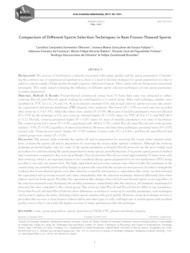Comparison of different sperm selection techniques in ram frozen-thawed sperm.
Comparison of different sperm selection techniques in ram frozen-thawed sperm.
Author(s): OLIVARES, C. C. S.; SOUZA-FABJAN, J. M. G. de; FONSECA, J. F. da; BALARO, M. F. A.; FREITAS, V. J. de F.; OLIVEIRA, R. V. de; BRANDÃO, F. Z.
Summary: Resumo: Background: The success of fertilization is directly associated with semen quality and the sperm preparation. Considering the common use of cryopreserved spermatozoa, there is a need to develop strategies for sperm preparation in order to achieve a sperm sample of high quality through a rigorous selection of sperm. Thus, sperm cells are being more extensively investigate. This study aimed evaluating the influence of different sperm selection techniques on ram sperm parameters in semen preparation. Materials, Methods & Results: Frozen-thawed commercial semen from 10 Santa Inês rams was subjected to either: swim-up, Percoll, mini-Percoll, sperm washing by centrifugation or a control group. After each technique, samples were incubated at 37°C for 1 h, 2 h and 3 h. At post-selection moment (0 h) and at each interval, sperm recovery rate, motility, capacitation and plasma membrane (PM) integrity were analyzed. The lowest (P < 0.05) recovery rate was recorded after swim-up (1.0 ± 0.3%), whilst the others were similar (P > 0.05). Most part of motility parameters were not affected (P > 0.05) by the technique at 0 h; just swim-up obtained higher (P < 0.05) values for VSL (41.8 ± 11.1) and VAP (46.9 ± 11.2). Overall, swim-up presented higher (P < 0.05) values for most of motility parameters over time of incubation. The control group led to more (P < 0.05) capacitated cells (46.8 ± 2.3%), whilst Percoll, mini-Percoll and swim-up were similar (~33%; P > 0.05), regardless of interval incubation. However, the latter three techniques presented more (P < 0.05) reacted cells. Swim-up recovered a higher (P < 0.05) number of intact cells (32.1 ± 6.4%), and Percoll, mini-Percoll and control group were similar (P > 0.05). Discussion: The present study evaluated the sperm cell and its preparation for receiving the oocyte under optimal conditions. evaluate the sperm cell and its preparation for receiving the oocyte under optimal conditions. Although the swim-up technique promoted higher rates for some of the sperm parameters evaluated, Percoll protocols are the most widely used procedures for selection during the sperm preparation in many species, possibly because of its greater speed, practical method and convenience compared to the swim-up technique. Percoll and mini-Percoll recovered approximately 10 times more cells than swim-up, which is an important feature to be considered during sperm preparation for in vitro fertilization (IVF), being possible to use only one semen straw. The high capacitated and acrosome reaction rates observed after the treatments in the current study, are probably reinforced by changes in sperm cells caused by the cryopreservation process. In order to strength the evidence that frozen-thawed sperm, even after selection, is sensible and reactive to capacitation-like events, we demonstrated the capacitated and acrosome-reacted cell values immediately after the selection treatments behaved differently than when authors used ram fresh sperm. Possibly, this capacitation-like changes observed in frozen-thawed sperm occurs regardless of the selection treatment used. Analyzing the motility parameters immediately after the selection, all treatments maintained or increased the rates compared to the control group. The swim-up, mini-Percoll and Percoll did not differ in any parameters. Given that Percoll and mini-Percoll did not show differences in relation to swim-up for motility parameters, such techniques can be used to replace the latter, obtaining similar sperm samples with good quality. However, swim-up technique involves a procedure that recovers a clean fraction without debris and other types of cells, with high rate of mobile sperm with excellent quality, reason why it can justify the higher recovery of intact spermatozoa after the technique.
Publication year: 2017
Types of publication: Journal article
Unit: Embrapa Goats & Sheep
Observation
Some of Embrapa's publications are published as ePub files. To read them, use or download one of the following free software options to your computer or mobile device. Android: Google Play Books; IOS: iBooks; Windows and Linux: Calibre.
Access other publications
Access the Agricultural Research Database (BDPA) to consult Embrapa's full library collection and records.
Visit Embrapa Bookstore to purchase books and other publications sold by Embrapa.

